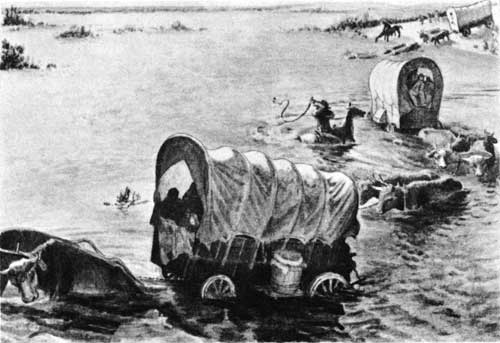|
SCOTTS BLUFF National Monument |
 |

Emigrants fording the Platte.
Original sketch in Oregon Trail Museum.
Years of Decision, 1846-48
In 1846, the Oregon Territory, long in dispute with Great Britain, was finally acquired by peaceful compromise. The emigrant families who had passed Scotts Bluff had ensured this outcome by tipping the scales of population! Meanwhile, in May 1846, the United States had declared war on Mexico and, in the name of "manifest destiny," set about adding California and the Southwest to its territory.
The emigration of 1846 was lighter than that of the preceding year. One company, the Donner party, met appalling disaster in the early autumn snows of the Sierra Nevadas. Edward Bryant, a future Governor of California, and J. Quinn Thornton both wrote the most extravagant and fanciful descriptions of Scotts Bluff and nearby hills. They imagined "the ruins of some ancient vast city," complete with domes, towers, temples, minarets, amphitheaters, frowning parapets, and even "a royal bath," a fittingly picturesque backdrop for the lingering death of "the unhappy trapper" who crawled here after being abandoned by "inhuman companions."
In 1846 young historian Francis Parkman, whose journal, The Oregon Trail, would become one of the classics of our literature, made his famous trip to Fort Laramie. After camping "by the well-known spring on Scott's Bluff" he rode out in the morning and "descending the western side of the bluff" came upon "old Smoke's lodges." Here he launches into his first exciting description of a Sioux encampment, with its handsome lazy warriors, dusky maidens, and the "old withered crones" who did all the work!
Also in 1846, after mob violence against their city of Nauvoo, Ill., the Mormons began their great western trek. They encamped for the winter on the Missouri at Kanesville (Council Bluffs) and Winter Quarters (Omaha), where hundreds died of disease and exposure. In the spring of 1847 the mormon pioneers, 144 strong under Brigham Young, traveled to their promised land, Great Salt Lake Valley in Utah. Avoiding the "gentiles" who followed the Oregon Trail up the south bank of the Platte, the Mormons remained on the north bank until they reached Fort Laramie, using the old trappers' trail to Fort Atkinson. Probably no expedition in history has been better chronicled. Among the many meticulous Mormon journalists was William Clayton, who later wrote one of the better trail guides. On May 27 he reported that the company "passed the meridian of the northernmost peaks of Scott's Bluffs." The view toward these bluffs, "resembling ancient ruins, was "majestic and sublime."
The mormon emigration almost monopolized the trail in 1848. Some 4,000 of the faithful journeyed to Utah up the north bank, opposite the bluff, while a comparative handful of emigrants followed the usual route to Oregon. But this was the quiet before the storm. In 1848 James Marshall discovered gold on Captain Sutter's ranch. The news traveled by fast clipper ship around Cape Horn to New York City. The California gold rush would soon burst in a torrent up the North Platte migration corridor.

|

|
|
Last Modified: Sat, Dec 9 2000 10:00:00 am PDT |


